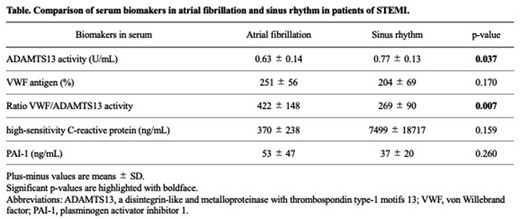-
PDF
- Split View
-
Views
-
Cite
Cite
T Osawa, Y Ito, K Nakano, Y Yamada, Y Abe, F Tabata, T Koizumi, Comparison of VWF-ADAMTS13 axis involvement in atrial fibrillation and sinus rhythm in patients with ST-elevation myocardial infarction, European Heart Journal, Volume 43, Issue Supplement_1, February 2022, ehab849.080, https://doi.org/10.1093/eurheartj/ehab849.080
Close - Share Icon Share
Abstract
Type of funding sources: None.
Previous studies have shown that von Willebrand factor (VWF) increases, and a disintegrin-like and metalloproteinase with thrombospondin type-1 motifs 13 (ADAMTS13) decreases in myocardial infarction. Few studies have examined the involvement of the VWF-ADAMTS13 axis in ST-elevation myocardial infarction (STEMI) patients with atrial fibrillation (AF).
Our aim was to investigate VWF-ADAMTS13 axis involvement in atrial fibrillation in STEMI.
The subjects of this study were participants in an observational study for investigating the difference in the pathology of thrombus retrieved from infarct-related artery between AF and sinus rhythm (SR). From June 2019 to August 2020, patients who underwent thrombus aspiration for STEMI at our hospital. Only subjects whose thrombus could be confirmed were enrolled. They were divided into two groups, the AF group, and the SR group. Serum biomarkers, including ADAMTS13 activity, and VWF were evaluated.
34 patients with STEMI who were able to aspirate thrombus were enrolled in the study. They were divided into two groups: 6 patients with AF (AF group, mean age 72.5 years, 100% male) and 28 patients with SR (SR group, mean age 63.0 years, 100% male). ADAMTS13 activity was significantly lower in AF group than SR group (AF: 0.63 ± 0.14 vs. SR: 0.77 ± 0.13 U / mL, p = 0.037). There was no significant difference in VWF antigen between the two groups (AF: 251 ± 56 vs. SR: 204 ± 69%, p = 0.170). VWF/ADAMTS13 activity in AF group were significantly higher than in SR group.

Abstract Table. Comparison of serum biomarkers



